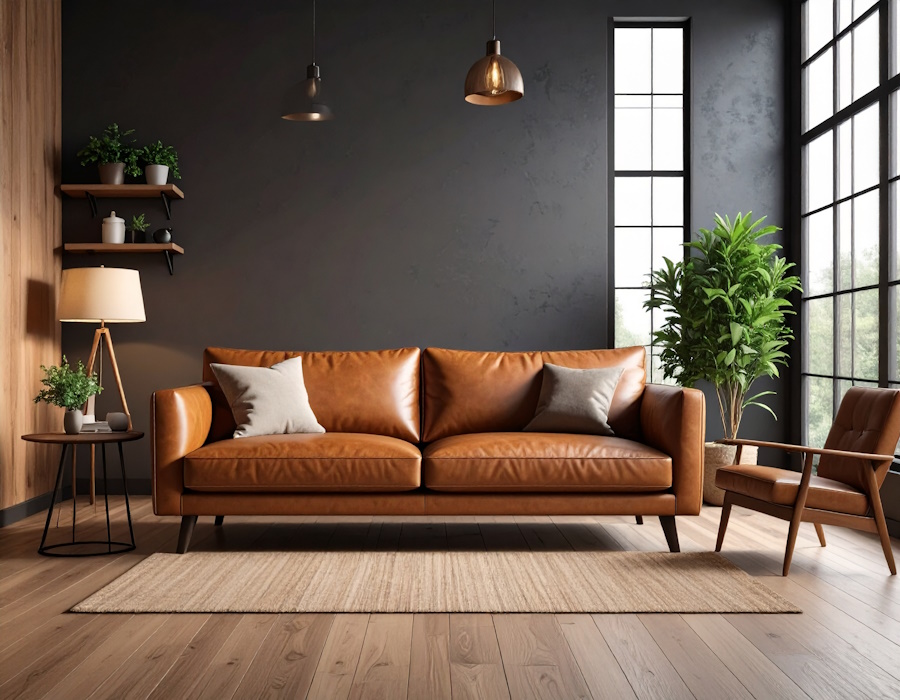
A leather sofa is more than just a piece of furniture — it's an investment in comfort, style, and longevity. But if you're shopping for leather furniture or have recently brought home your dream leather sofa, you might have a few questions.
Why doesn’t it look exactly like the picture online? Why is the leather wrinkling? And how do you keep it looking plush and well-cared for over time?
This guide combines expert tips and real-life insights to help you set expectations, understand common quirks of leather furniture, and learn how to care for your new addition so it stays looking great for years to come.
The Reality of Leather Sofa Colour: Why It Might Not Match the Photo
You’ve found the perfect sofa online, but when it arrives, the colour seems off. Maybe it’s a bit darker, lighter, or a touch warmer or cooler than you expected. This is a common and completely normal experience when buying leather furniture.
Why does this happen?
- Lighting Makes a Big Difference - Photos on websites are usually taken in bright showrooms or professional studios. Your home likely has softer, warmer, or uneven lighting that can change how colours appear. Even natural daylight varies by time of day.
- Screens Aren’t All the Same - Every screen—whether it’s a phone, laptop, or tablet—displays colours differently based on settings, brightness, or display technology. What you see online is always an approximation.
- Leather Is a Natural Material - Leather isn’t perfectly uniform. It absorbs dye unevenly, has natural grain and texture variations, and may display marbling or undertones not visible in online photos. Even sofas in the same colour category may look slightly different.
Takeaway:
Expect some natural variation. If exact colour matching is important, request a swatch before ordering or visit a showroom if possible, although this still could vary slightly, with differences between it and the final piece of furniture.
Fabric Warping & Wrinkles: What’s Normal (and What’s Not)
If your leather sofa starts to develop ripples, puckers, or a slightly ‘baggy’ look, you’re not alone. This is a common occurrence called fabric warping, and it can happen to even the most premium leather furniture.
What causes fabric warping?
- Heat & Humidity - Leather reacts to its environment. It expands in humid conditions and contracts when dry. Fluctuations over time can cause stretching or shifting.
- Weight Distribution & Use - Sitting repeatedly in the same spot compresses both the leather and the internal filling, causing uneven wear and occasional sagging.
- Temperature Changes - Leather becomes softer in warm environments and stiffer in the cold. Constant temperature shifts can eventually affect its structure.
How to Minimise Warping:
- Keep your sofa away from direct sunlight and heat sources.
- Use a humidifier or dehumidifier to maintain stable humidity.
- If possible rotate and reshape cushions weekly.
- Apply a leather conditioner every 6–12 months.
- Avoid putting excessive weight or pressure in one area.
Can It Be Fixed?
Minor ripples can often be massaged out with your hands. For more severe cases, a professional upholsterer can help re-tension the leather or address internal structure issues.
Keeping Leather Cushions Full: How to Plump Fixed Cushions
Leather sofas often come with fixed cushions—ones that aren’t removable or reversible. Over time, these cushions can start to look flat or deflated due to daily use.
Why Do Cushions Flatten?
Sitting compresses the filling, and without being able to flip or fluff the cushions, that filling tends to settle and lose shape.
How to Plump Them Back Up:
What you’ll need: Just your hands and a clean cloth.
Steps:
- Pat the Cushion - Firmly but gently pat and push the cushion to redistribute the internal filling, starting from the edges and working inward.
- Massage the Surface - Gently knead the cushion to break up any compacted areas and move filling into flat spots.
- Smooth the Leather - Use a soft cloth to gently wipe and smooth the leather surface.
- Repeat Regularly - Make this part of your weekly or monthly routine to keep your sofa looking full and inviting.
Additional Leather Sofa Care Tips
Before carrying out any cleaning on your leather sofa, always consult your care guide.
Regular Dusting & Cleaning
- Dust weekly with a soft, dry cloth.
- Clean with a slightly damp cloth every few weeks.
- Avoid harsh detergents or household cleaners — they can strip natural oils from the leather.
Conditioning the Leather
- Use a leather conditioner every 6–12 months to keep the material supple.
- Test any product on a hidden spot first.
Avoid Sharp Objects
- Be mindful of zippers, belt buckles, pet claws, and sharp toys — leather can scratch easily.
- Small scratches may fade over time or can be lightly buffed out with a leather balm.
Manage Temperature & Humidity
- Keep leather away from direct heat sources (like radiators) and out of direct sunlight.
- Maintain consistent indoor humidity to prevent drying or warping.
Use Throws and Cushions Strategically
- These aren’t just decorative — they help distribute weight, protect from spills, and reduce wear on high-contact areas.
Final Thoughts: Know What to Expect, and Love Your Leather Longer
Buying a leather sofa is an exciting upgrade — but it comes with its own set of quirks and care routines. Natural variations in colour, occasional warping, and the need to plump fixed cushions are all part of owning real leather furniture.
Understanding these factors can help you:
- Set realistic expectations when your furniture arrives.
- Appreciate the natural beauty and unique characteristics of leather.
- Take simple steps to care for your investment so it ages beautifully over time.
With a little knowledge and regular TLC, your leather sofa can be a stylish and comfortable centrepiece for your home for many years to come.
View the full range here